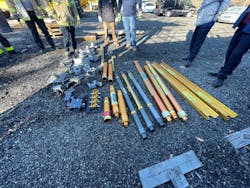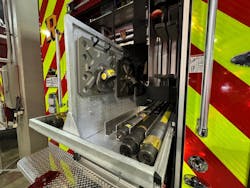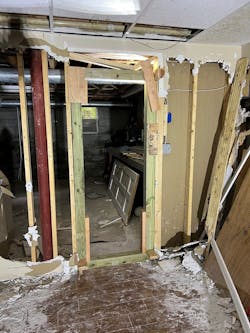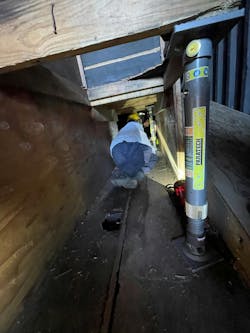Technical Rescue: Collapse Operations for Smaller Departments
Collapse operations seems to be a taboo topic at many fire and rescue departments. When the matter is discussed, many times, the conversation entails several issues, including training, funding, application and potential to respond. At the end of the day, firefighters must be ready and able to take action. There’s no worse feeling than to show up at an extremely high-risk/very-low-frequency incident and not be able to respond appropriately. Obviously, minimal action might be better for an overall operation, but it’s difficult to reprogram our mind to do less in order to do more.
Many of us decide to join a department and get involved so that we can have a positive effect on the community. Some of us move through the ranks to make changes, whether they are operationally or culturally. Departments around the country are tasked with firematic and, sometimes, rescue operations, such as mitigating motor vehicle entrapments and water emergencies. Furthermore, in many parts of the United States, infrastructure and buildings aren’t taken care of well, and in the world in which we operate today, people will do whatever they can to make things happen, whether it’s illegally expanding a basement area or taking care of their own structural renovations. The potential for structural collapse continues to increase every day, and all members must understand what to do in the event of a collapse.
Without going down the rabbit hole of collapse operations too soon, you should be reminded that many departments are outfitted with equipment that could be used in basic collapse operations. That said, it’s up to you and your department to develop a plan to be successful in the field.
Assessment
How do you assess your need? This isn’t as complicated as you might believe. Documenting and writing everything out might help to understand what’s needed.
Go through the department’s incident history and highlight times that you could have used a shoring/stabilization operation. The jurisdiction and first-due area drive the majority of the need and conversation. However, don’t be afraid to look at your second-due and mutual-aid areas. Regarding the latter, there might be benefits to looking at where you can help mutual-aid partners.
Next, consider what equipment your department has before you buy massive rescue trucks/trailers that are full of shoring materials. If your department is outfitted with a decent cache of collapse and stabilization equipment (e.g., from Paratech), chances are that you might have some basic ensembles that could help at an incident.
Buildings & mutual aid
Get out and look at your streets. Look at the homes, buildings and projects that are under development. Depending on the area of the country where your department is located, excavations and construction projects could be occurring rapidly.
More and more pedestal buildings that have masonry garages with lightweight wood-frame components above them are being constructed. Big box retailers and storage facilities are being built in a tilt/slab style. Private dwellings are being subdivided into multifamily dwellings and are being renovated with additions to increase their size.
Now, you might think to yourself, “We have an old city, and we have equipment. We might not need these capabilities.” Look at your mutual aid and your partners that are outside of the usual alarm card. Do any of these jurisdictions and organizations have these capabilities? Should you wait for a large metropolitan city or county resource to come to mitigate an emergency? You should aim to be the technical resource or the operational support resource. Within your mutual-aid groups, bring up this concept and see where the conversation goes. Perhaps what emerges is about developing a mutual-aid technical rescue program that allows for individual departments to take on a discipline as the primary agency and other departments to act as support.
Working together allows every department that’s involved to become more comfortable with each other and to understand each other’s capabilities. Mitigation of most “technical” incidents requires calculated steps. Rushing to make a move might create more issues for both victims and rescuers.
Capabilities & limitations
It’s imperative for leaders of a department to understand the capabilities of the department and limitations of the goals that are set for it. Those capabilities and limitations should be understood throughout the department, mutual aid, region, coordinators, etc.
Sometimes, an operation might require an additional strut or a plethora of lumber. In some departments, the closest collapse resource might be minutes or hours away. Understanding a department’s capabilities is a key factor, because that guides what training and equipment that the department must maintain.
At the end of the day, everything that members do is a perishable skill. Training helps with keeping skills sharp and at the ready. Knowing limitations is vital to the operation and allows the development of a continuous operations plan that should be ready when the department is activated to respond.
If your department is trained to mitigate basic collapses in private dwellings and to build out temporary T shores and Double T shores to make emergency access, the department shouldn’t be in line to operate at a large commercial collapse that requires advanced resources. Nothing says that a department can’t work toward obtaining that goal of becoming highly functioning and well trained, but leaders must be realistic when they develop these plans. They take time, training, equipment and commitment.
Buy-in
Having buy-in is paramount to anything in life. In the fire service, having buy-in of a highly efficient, aggressive culture can make a difference when there’s a viable victim in a house fire. In the rescue world, having the buy-in to training and to staying prepared can make a difference regarding the longevity of a department’s emergency shoring program.
How is such an environment fostered? High-ranking officers who force such a program without firefighters understanding the “why” face challenges. There’s a higher potential for buy-in when understanding of the project is developed and firefighters are taught prior to jumping in. Further, it’s vital to continue to educate as the program grows.
Funding
How is this kind of project funded? In a volunteer department, funding might affect the equipment and training. In a career department, funding could determine whether salaries and overtime to take part in training sessions are covered. In addition, there’s a need for finances to fund equipment and apparatus to transport the respective gear.
Chances are that your department, jurisdiction, commissioners and those who fund you aren’t able to cut a check to pay for such a program immediately. Using all of the aforementioned information and facts allows a proposal to be created for those who fund the department.
Start the conversation
If the department, jurisdiction and/or taxpayers provide millions of dollars of equipment, understanding why, how and when to use it is required. For example, a person drives his/her vehicle through the overhead door of a two-car garage, compromising the center support between garage doors. The driver appears to be having a medical emergency. Will members sit on the sidelines and wait for the technical team to show up from an hour away? Will they deploy struts to establish emergency temporary shores to remove the patient? Start this conversation in the office among the officers. Afterward, bring it to the members who would respond.
If there’s a need and it might be justified, start the research. Look into current equipment. Seek credible training on the respective topic. For the purposes of this article, the subject was emergency shoring. In the grand scheme of things, it might be any specialization.
About the Author

Robert Policht
Robert Policht, who is a Firehouse contributing editor, is lieutenant of Ladder Co. 2 of the Passaic, NJ, Fire Department. He assisted with developing and establishing the department’s response to human vs. machine incidents and is attached to the Fire Investigation Unit. Policht started his career as a volunteer and has served as a chief of department. He taught at the Bergen County, NJ, Fire Academy and is a member of the NJ Division of Fire Safety's Fire Threat Task Force. Policht has a master’s degree in emergency management and homeland security from Arizona State University and has been published in several trade publications. He is a founder of and contributor to Flow and Vent, which is a website that's dedicated to fire and rescue training.




